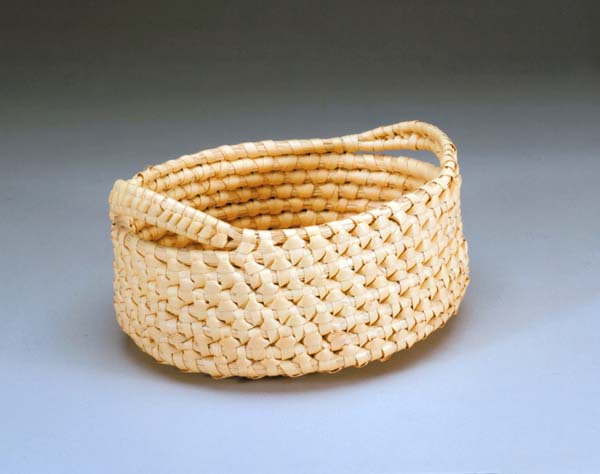Houma Nation
The United Houma Nation claims approximately 17,000 members and continues to keep Native American traditions alive from their tribal center in Lafourche Parish.

Courtesy of New Orleans Museum of Art
Basket with Handles. Luster, Janie Verret (Weaver)
In 1682, when French explorer René-Robert Cavelier, Sieur de La Salle, journeyed down the Mississippi River, he heard rumors that the Houma Indian nation lived on the eastern banks near present-day West Feliciana Parish. Although his journal entries provide the first written documentation of the Houma, the tribe did not come into direct contact with Europeans until 1686, when explorer Henri de Tonti passed through its village. In the eighteenth century, the Houma—a small, Muskogean-speaking, agricultural people—established important trade and political relationships with the French and Spanish colonists. As a community, they managed to survive and to maintain their identity through the Louisiana Purchase and increased settlement by Americans and immigrants. Today, the United Houma Nation (UHN)—a modern group whose tribal center is located in Golden Meadow, in Lafourche Parish—claims descent from this historic tribe. Although the UHN has been recognized as a Native American community by the State of Louisiana, it has been denied federal recognition.
The Houma Nation in French Louisiana
During the first decades of the eighteenth century, the Houma moved downriver from their location above present-day Baton Rouge, responding, in part, to pressure from other Native American groups in the region. As European colonists expanded westward, for example, their traders penetrated further into the continent’s interior. To obtain goods and Indian slaves, as well as to intimidate enemy nations, these traders and their Native American allies conducted violent raids along the eastern shores of the Mississippi River that, in turn, caused Native nations located in this region to flee. As a result of these frequent raids, the Tunica Indians—historically located to the north of the Houma—moved south and settled in Houma territory. In 1706, tensions between the two tribes flared, and the Tunicas massacred their hosts. The surviving Houma fled downriver in search of safer living arrangements and chose to relocate closer to the French colonists. Settling on the fertile lands north of Lake Pontchartrain, along the Mississippi River and across from Point Coupee Parish, the Houma raised corn, beans, hens, and other foodstuffs, which they brought into New Orleans to trade. By the 1720s, the Houma were active participants in Louisiana’s colonial economy, building strong trade and military alliances with the French.
Compared to other tribes, the Houma were few in number. Pierre Le Moyne, Sieur d’Iberville, recorded their population at 350 men in 1699. Integral to the survival of the early Louisiana colonists, petite or small Indian nations helped supply the French settlers with food and material goods during shortages. Throughout the French colonial period (1682–1762), the Houma also regularly served as scouts for colonial ventures and supported the French during military conflicts with other Native American nations. Although relatively few in number, the Houma held land on both sides of the Mississippi River and were numerous enough to comprise two distinct communities. Historical documents from this period indicate that during the 1730s, the Houma were split into two villages: one on the eastern and another on the western bank of the Mississippi River. Because the village on the eastern bank was larger, the French government recognized it as the seat of Houma political power. These two Houma groups remained geographically separated until the 1760s, when they reunited on the western side of the river.
The Houma Nation in Spanish Louisiana
This reunion happened, at least in part, because of the geopolitical reorganization of the region during the French and Indian War (1754–1863), which was part of the global Seven Years’ War. The victors of this struggle—the British and their Native American allies—gained sizable territorial spoils in North America. As part of the peace agreements in the Treaty of Paris, signed on February 10, 1763, French King Louis XV transferred all of France’s colonial land holdings east of the Mississippi, excluding the Isle of Orleans, to the British Crown. In addition, France gave its wartime ally, Spain, the western half of the Louisiana territory, including New Orleans, in a secret treaty a year before the war ended.
These transfers took place, however, without the knowledge or consent of the Native American nations living within the territories. Distressed by the land transfer, the loss of alliances with the French, and the changes in colonial governance, several tribes, including the Houma, responded by forging new relationships and relocating to areas of Spanish control. The Houma who lived on the eastern bank of the Mississippi, for instance, crossed west into Ascension Parish in 1763 to avoid living in British territory. Presumably, they believed their community would fare better in Spanish Louisiana.
Despite this move, the Houma did not interact with Spanish forces exclusively. Native Americans of the Lower Mississippi Valley—which had served as a buffer zone between European empires during the late seventeenth and the eighteenth centuries—had experience with “play-off diplomacy.” Living amid competing Western empires allowed the Houma and other Indian nations to negotiate with multiple colonial governments simultaneously. It also meant that Native Americans could form multiple alliances based on the political or economic advantages offered by the English, Spanish, and French. Essentially, this placed American Indians in a position of increased power. As a result, the Spanish colonial government continued to court the favor of the Houma nation in order to maintain their alliance. In 1769 Spanish governor Alejandro O’Reilly invited the chief of the Houma to New Orleans to participate in a ceremony affirming the tribe’s loyalty to the Spanish empire. As a symbol of the alliance O’Reilly gave the chief a medal and some small gifts.
Throughout the eighteenth century, the Houma continued to trade with European settlers and other Native American nations. They relied on seasonal production practices—farming, planting, hunting, fishing, and raising chickens— during the warm months of the year and then moved to the outskirts of New Orleans to market these goods during the winter months. These patterns of small-scale agriculture and trade continued into the American period.
The Houma Nation after the Louisiana Purchase
In 1803 the Louisiana Purchase, dramatically expanded the geographic borders of the United States. The Houma people—who had previously negotiated with the English, French, and Spanish—now had to deal with the US government as well as an exploding population of Anglo-American settlers pressing into the lower Mississippi River valley. US territorial officials, unlike their European predecessors, were not especially concerned with protecting the local tribes’ land claims or property, especially when American settlers challenged them.
Nonetheless, the Houma made repeated efforts to gain federal recognition and build political alliances with the US government during the first decade of the nineteenth century. For instance, in 1806 Houma representatives from Ascension Parish met with territorial governor William C. C. Claiborne to discuss political matters. Similarly, in 1811 Chief Chac Chouma met with Claiborne to reaffirm the Houma’s friendship and receive presents from the governor. Yet no formal treaty was ever made, and Claiborne estimated that, at that time, the Houma nation did “not exceed eighty souls.”
As American settlers pressed into the Louisiana territory, conflicts with local tribes escalated, resulting in violence and anti–Native American sentiment among the settlers. Like many other Native tribes in the region, the Houma were pushed into the bayous and onto less desirable tracts of land. During the nineteenth century, the Houma gradually moved south to their current settlements along the bayous of Terrebonne and Lafourche Parishes, where they remained relatively isolated through the first half of the twentieth century. The Houma tribe continued to live and support themselves in this swampy environment by hunting, fishing, weaving baskets and mats, and farming.
Today—generations after they resettled from their tradition homeland into Acadian lands of South Louisiana and intermarried with local Acadians—the Houma are regarded as keepers of Louisiana French, as the language is dying out across the rest of Cajun country. Historian Carl Brasseaux has noted: “The 1990 census indicated that approximately sixty percent of the Houma residing in Terrebonne Parish and almost fifty percent of the Lafourche Parish Houma over five years of age spoke Cajun French as their first language. Approximately twenty percent of the Houma in both parishes reported that they did ‘not speak English very well.’”
In the twentieth century, the Houma struggled for political recognition. After facing racial discrimination and educational disadvantages in the first half of the century, the Houma in Terrebonne and Lafourche Parishes strove, from the 1960s onward, to turn their communities into a unified political entity. In 1979 two tribal units—The Houma Tribes Inc. and the Houma Alliance—merged to create the United Houma Nation, Inc., which claimed descent from the historic Houma tribe. The state of Louisiana officially recognized the Houma nation in 1977; eight years later, the UHN submitted to the US Department of the Interior a petition for federal acknowledgement. Hopes that federal recognition would increase the tribe’s political power and land rights were dashed in 1994, when the department found that the Houma did not meet the criteria. To date, the UHN remains unrecognized by the federal government, but they have not given up the fight. Currently, the Houma community claims approximately 17,000 members and continues to keep Native American traditions alive, proudly asserting their identity.
